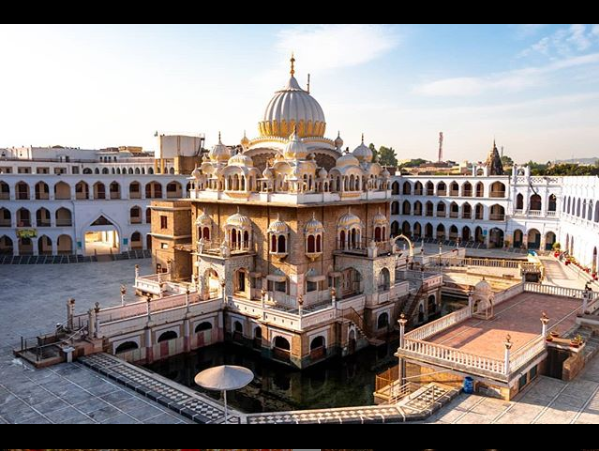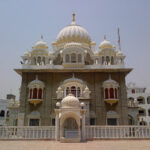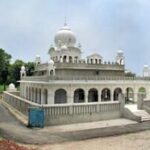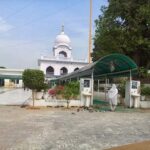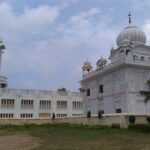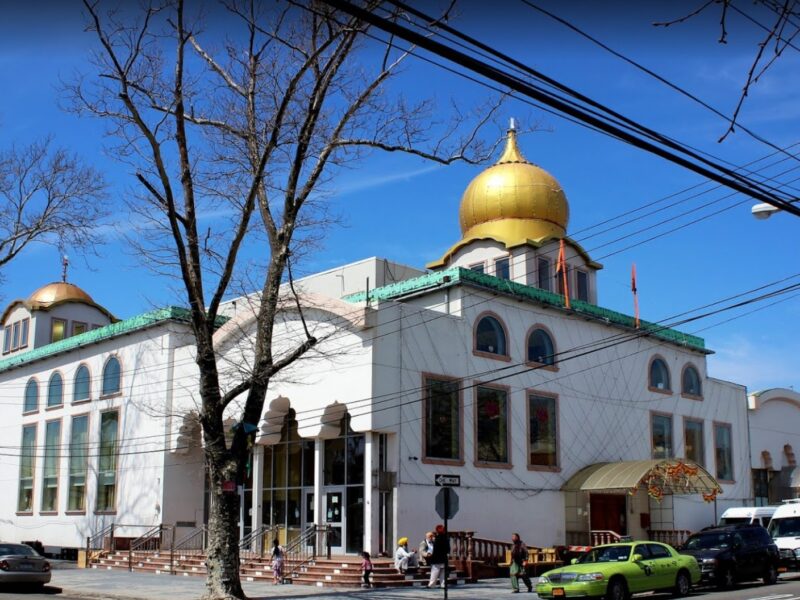Gurdwara Panja Sahib is located in Hasan Abdal, 48 km from Rawalpindi, Pakistan. This is one of the holiest sites in Sikhism as it marks the place where the founder of the faith, Guru Nanak Dev, visited and instilled an important lesson in his followers. Still visible is the sacred stone with the handprint of Guru Nanak.
Many thousands of faithful Sikhs from all over the world visit this shrine. However, twice a year, during special celebrations, this Gurdwara is attended by a huge number of Sikh pilgrims from all over the world. The Pakistani government is issuing special visas to meet the increased demand.
The word “Panja” in Punjabi means “outstretched palm” from the word “panj” which means “five”.
Guru Nanak along with Bhai Mardana reached Hasan Abdal in Baisakh Samwat 1578 B.C. which corresponds to 1521 AD in the summer season. Under a cool shade tree, Guru Nanak and Bhai Mardana began reciting kirtan (sacred hymns) and their devotees gathered around. This angered Wali Qandhari, but he was helpless.
According to legend, Bhai Mardana was sent three times to Wali Qandhari to provide him with some water to quench his thirst. Wali Qandhari refused his request and was rude to him. Despite this, Mardana still very politely adhered to his request.
Wali remarked wryly, “Why don’t you ask your Master who you serve?” Mardana returned to the Guru in a miserable condition and said, “Oh, sir! I prefer death to thirst, but I will not approach the egoist Wali again.” The Guru replied, “Oh Bhai Mardana! Chant the name of God, the Almighty; and drink water to your heart’s content.”
The Guru set aside a large stone lying nearby and a pure fountain of water gushed forth and began to flow endlessly. Bhai Mardana quenched his thirst and felt grateful to the Guru. On the other hand, the Wali Qandhari fountain dried up around the same time.
When the Wali witnessed this, in his anger he threw a part of the mountain, a huge stone at the Guru from the top of the hill. The Guru stopped the thrown stone with his hand and left an imprint of his hand in the rock. Wali observed this miracle and became the Guru’s devotee. This holy and revered place is now known as Panja Sahib.
Guru Nanak raises his right arm to stop a huge stone rolling towards the sangat at the foot of the hill
Like all legends and folklore, the story of Panja Sahib sounds like a mixture of belief, fact and fiction – fiction for non-believers. There are different details between the different versions of the story that one hears or reads on the internet. However, there is a clear common thread running through them all. Apart from the Sikh caretaker or Granthi of the shrine, I also spoke to some of the locals of Hasan Abdal about the story of Panja Sahib. Each gave me a similar, if not exactly the same account; and everyone seemed to believe it too. Here is the story in its basic details:
Sometime between 1510 and 1520, Guru Nanak is said to have traveled to Arab countries, visiting Mecca and Baghdad, among other places. Some suggest that he even performed the Hajj, but there is no conclusive evidence of this. (To give the reader an idea of the time line, this was just before Babar’s invasion and the Mughal rule in India.) On his way back from his sojourn abroad, Guru Nanak passed through Kabul and Peshawar, and after crossing the Indus, stopped at a small village in the foothills of a steep hill, not far from Margallas, where Hasan Abdal resides today.
Attracted by his teachings, Muslims and Hindus from the village and its surroundings began to flock to Guru Nanak. On the top of the hill behind the Guru’s village lived a ‘pir’ (a Muslim ‘saint’ of sorts). He was called Baba Wali Kandhari. His surname referred to his origins in Kandhar, Afghanistan. Besides a better vantage point from where he could see all that was happening in the village below, Baba Kandhari also had the advantage of having a spring of fresh water nearby. The spring was also the only source of water for the people below.
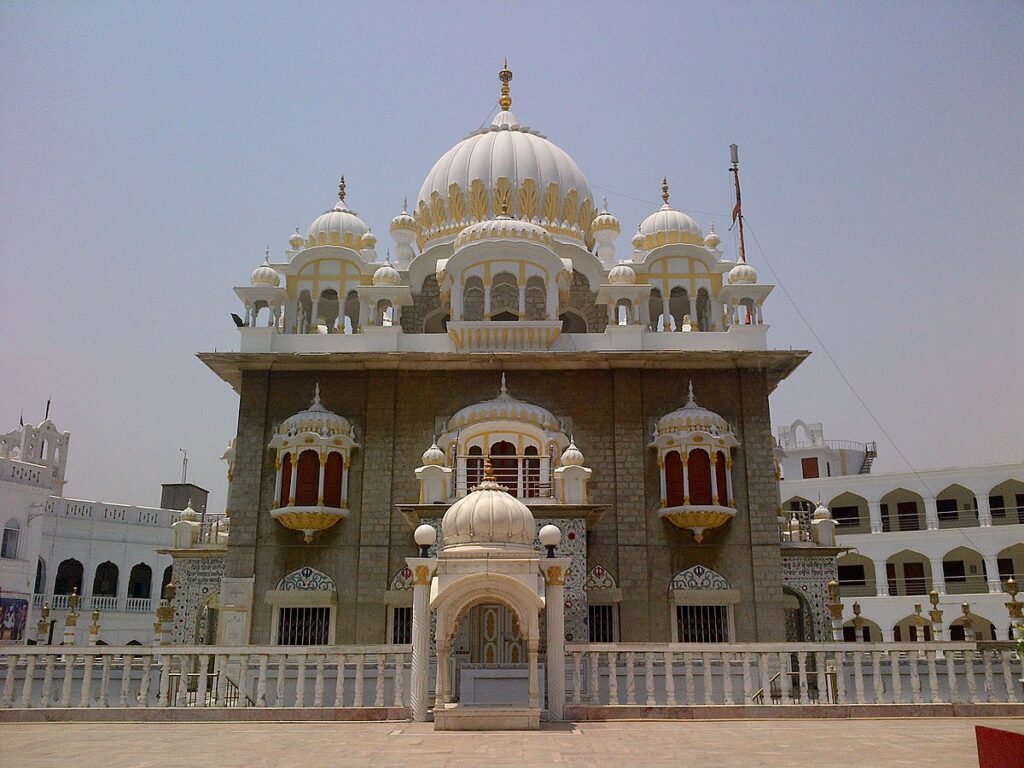
Handprint of Guru Nanak imprinted on a rock in Panja sahib
Baba Kandhari could not fail to notice the ‘new saint on the block’ as it was said. He saw that many more people flocked to Guru Nanak than visited him. He felt a little grudge against the Guru. What should he do? If he couldn’t stop the flow of people towards the Guru, he thought, he could stop the flow of water to the village below and drive the Guru away. And stop the water he did.
A delegation of people from the village, naturally upset at the interruption of the water supply, went to Baba Kandhari and asked him to be so kind as to let the water flow again. But Baba angrily sent them back and taunted them that why didn’t they ask their Guru to make water for them.
On hearing this, Guru Nanak asked his lifelong disciple and companion, Bhai Mardana (a Muslim) to go to Baba Kandhari and plead the case of the village people. But Baba did not relent and Bhai Mardana returned empty-handed. Guru Nanak sent Bhai Mardan again and again to beg Baba for water, but to no avail.
Desperate, the people approached Guru Nanak and asked him what they should do. According to the story, Guru Nanak told them not to despair and trust in God, and then, pointing to a large stone, asked them to free it from where it was embedded in the ground. When they pushed the rock aside, fresh water gushed out of the ground, enough for a small village and then some!
Baba Kandhari saw all this from the top of the hill and was surprised and horrified at the same time. But his dismay turned to shock and rage when he discovered that his own spring had dried up in the meantime. Enough is enough, he thought, and decided to end the guru. He pushed a huge boulder down the hill towards the Guru which, he thought, would surely crush the Guru and the people around him.
The boulder rolled down, picking up speed, digging up dirt as it moved. When the people heard the crash and saw the huge rock coming down, they panicked and ran away. But Guru Nanak remained calm and continued to sit where he was. As the boulder approached, Guru Nanak calmly raised his right hand as if to command the rock to stop. The boulder leaned against his arm and stopped!
Water flowing from under a stone
The Guru’s open hand imprinted itself on the boulder as if pressed into wax. Seeing this, Baba Kandhari needed no further proof of the Guru’s spiritual reach. He came down from the hill, touched the feet of Guru Nanak and joined the group of his devotees. The handprint rock is today embedded in the concrete structure of the Panja Sahib building complex.
